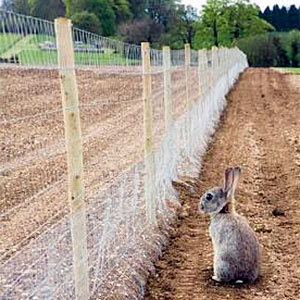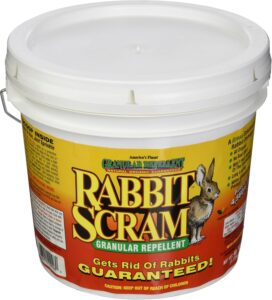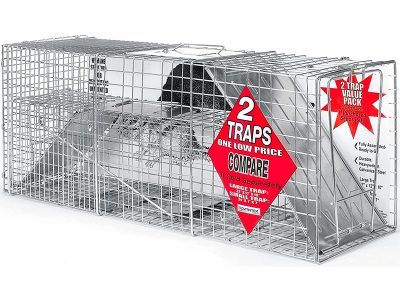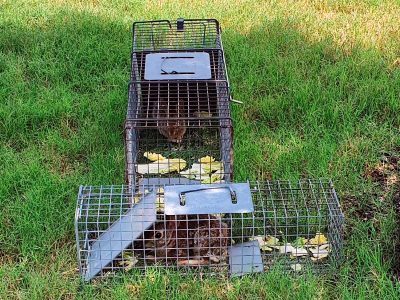Rabbits may appear cute and harmless, but they can quickly become a gardener’s nightmare. These small mammals have voracious appetites and can devastate gardens, flower beds, and landscaping within days. This comprehensive guide provides effective, proven methods to protect your yard and garden from rabbit damage, using both humane deterrents and physical barriers that really work.
Quick Picks: How to Get Rid of Rabbits from Your Yard or Garden

Most Effective

Best Deterrent

Catch & Release
- How to Identify Rabbit Damage in Your Yard
- Physical Barriers: The Most Effective Rabbit Control Method
- Habitat Modification: Make Your Yard Less Rabbit-Friendly
- Natural and Commercial Repellents That Actually Work
- Humane Trapping and Relocation
- Rabbit-Resistant Plants for a Protected Garden
- Electronic and Mechanical Deterrents
- Creating an Integrated Rabbit Management Plan
- Conclusion: Maintaining a Rabbit-Free Garden
- Frequently Asked Questions
- Additional Resources
How to Identify Rabbit Damage in Your Yard

Before implementing rabbit control measures, it’s important to confirm that rabbits are indeed the culprits causing damage to your garden. Here are the telltale signs of rabbit activity:
Clean-Cut Damage
Rabbits leave clean, 45-degree angle cuts on stems and twigs, making plants look like they’ve been trimmed with pruning shears rather than torn or ripped.
Droppings
Look for small, round fecal pellets (about 1/4 inch in diameter) scattered around damaged plants – these are a definitive sign of rabbit presence.
Footprints
Rabbit tracks have a distinctive pattern with larger hind feet and smaller front paws, often visible in soft soil, mud, or snow.
Bark Damage
During winter, rabbits gnaw on bark of young trees and shrubs, which can cause serious damage or even kill plants by girdling.
Understanding when and where rabbit damage occurs is crucial. Rabbits are most active at dawn and dusk but can feed throughout the day and night. In spring and summer, they primarily target tender plants, vegetables, and flowers, while in fall and winter, they often damage woody plants by gnawing on bark.
Physical Barriers: The Most Effective Rabbit Control Method
Experts consistently recommend physical barriers as the most reliable method to protect your garden from rabbits. Fencing and other physical deterrents provide immediate protection that doesn’t wash away or need frequent reapplication.
Amagabeli 36 Inch x 50ft Hardware Cloth Fencing
Editor's ChoiceHow Does It Work
How to Use
- Install fencing at least 2 feet high around garden perimeters
- Bury the bottom 6-8 inches below ground or bend it outward at a 90-degree angle
- Secure to sturdy posts spaced 6-8 feet apart
- Ensure there are no gaps at entry points or between fence sections
- For tree protection, create cylindrical guards using the same fencing material
- Provides immediate and consistent protection
- Lasts for many years with minimal maintenance
- Completely humane solution that doesn't harm rabbits
- Small mesh size prevents juveniles from entering
- Weather-resistant and durable in all seasons
- Requires initial time investment for proper installation
- More expensive upfront than repellents
- May be visually unappealing in ornamental gardens
- Requires monitoring for digging attempts at the base
How to Install a Rabbit-Proof Fence
For maximum effectiveness, follow these guidelines when installing rabbit-proof fencing:
- Choose the right materials Use 1/4-inch or 1/2-inch hardware cloth or chicken wire with small openings that young rabbits cannot squeeze through.
- Proper height Make fence at least 2 feet tall, as most rabbits won’t jump over this height.
- Prevent digging Bury the bottom portion 6-8 inches underground or bend it outward at a 90-degree angle to create an L-shape that prevents burrowing.
- Secure installation Use strong posts every 6-8 feet to maintain fence integrity, especially during winter when snow can push against fencing.
- No gaps Ensure gates close tightly and there are no spaces where rabbits can squeeze through.
Protecting Individual Plants and Trees
For individual trees, shrubs, or prized plants, create protective barriers using the same fencing materials:
- Create cylindrical tree guards using hardware cloth that extends at least 2 feet above expected snow level
- Leave 1-2 inches of space between the guard and the trunk to allow for growth
- For smaller plants, create dome-shaped or box-shaped cages using hardware cloth
- Secure wire cages with landscape pins or stakes to prevent rabbits from pushing them aside
Habitat Modification: Make Your Yard Less Rabbit-Friendly
Rabbits need shelter and hiding places to feel safe. By modifying your landscape to be less hospitable to rabbits, you can significantly reduce their presence:
| Strategy | How It Works | Implementation Tips |
|---|---|---|
| Remove Dense Cover | Eliminates hiding places and nesting sites | Clear brush piles, tall grass, and dense shrub thickets where rabbits might hide |
| Regular Lawn Maintenance | Creates exposed areas rabbits avoid | Keep grass mowed short, particularly around garden perimeters |
| Remove Access to Structures | Prevents nesting under decks, sheds, etc. | Install wire mesh barriers around the base of structures where rabbits might nest |
| Fill Burrows and Holes | Discourages rabbits from establishing permanent homes | Fill abandoned rabbit burrows with soil and rocks |
| Create Open Space Buffers | Makes rabbits uncomfortable due to exposure to predators | Maintain a 2-3 foot cleared perimeter around gardens and valuable plants |
Natural and Commercial Repellents That Actually Work
Repellents can be effective as part of an integrated rabbit control strategy, particularly for areas where fencing isn’t practical or visually desirable. These work by creating unpleasant tastes, odors, or fears that deter rabbits from feeding on your plants.
Rabbit Scram Granular Repellent
Most Effective RepellentHow Does It Work
How to Use
- Apply a 6-8 inch wide perimeter around garden beds or plants requiring protection
- Use 1 pound per 300 square feet of perimeter area
- Reapply every 30-45 days or after heavy rain
- For established rabbit problems, make the initial application heavier
- Can be used in any season and is safe around food plants when used as directed
- All-natural formula safe for use around children and pets
- Lasts up to 45 days between applications
- Effective in all seasons and weather conditions
- No harsh chemicals or offensive odors for humans
- Won't harm plants or soil
- Requires regular reapplication, especially after heavy rain
- May not deter extremely hungry rabbits during food scarcity
- More expensive than homemade alternatives
- Not effective for rabbits already inside fenced areas
Effective Homemade Rabbit Repellents
If you prefer a DIY approach, these homemade solutions can be effective when applied consistently:
DIY Hot Pepper Spray Recipe
- 1 gallon water
- 5 cloves crushed garlic
- 1 tablespoon crushed red pepper flakes or hot sauce
- 1 tablespoon mild dish soap (acts as a sticking agent)
Mix ingredients and let steep for 24-48 hours. Strain and spray on plants, reapplying after rain or every 7-10 days.
Other effective homemade repellents include:
- Irish Spring Soap Deterrent: Cut bars into small cubes, place in mesh bags, and hang around garden perimeters or stake near vulnerable plants
- Blood Meal Fertilizer: Sprinkle around garden edges (bonus: adds nitrogen to soil)
- Human Hair: Collect hair from brushes or get from local salons, scatter around garden beds
- Predator Urine: Commercial preparations of fox or coyote urine create fear response
- Vinegar Spray: Mix equal parts white vinegar and water, spray around perimeter (avoid direct plant application)
Tips for Successful Repellent Use
To maximize the effectiveness of any repellent:
- Apply before rabbit damage begins – prevention is easier than breaking established feeding patterns
- Reapply consistently according to product instructions, especially after rain
- Create a perimeter around entire garden areas rather than just treating individual plants
- Rotate between different repellent types to prevent rabbits from becoming accustomed to any one deterrent
- Combine repellents with other control methods for better results
Humane Trapping and Relocation
Live trapping can be effective for reducing rabbit populations, particularly in areas where other methods aren’t sufficient. This approach allows you to relocate rabbits without harming them.
Advantek Catch and Release Cage Trap
Humane SolutionHow Does It Work
How to Use
- Place the trap in areas with visible rabbit activity or along their travel paths
- Bait with fresh vegetables like carrots, lettuce, or apple slices
- Position the open end of the trap facing the rabbit's path
- Check traps at least once daily (morning and evening is best)
- Wear gloves when handling traps with captured rabbits
- Release rabbits in suitable habitat at least 5 miles from your property
- Humane solution that doesn't harm rabbits
- Durable construction built to last multiple seasons
- Easy to set up and use, even for beginners
- Effective for targeted removal of problem rabbits
- Can be reused indefinitely with proper care
- Time-intensive as traps must be checked regularly
- May not be practical for large rabbit populations
- Some areas have restrictions on relocation of wildlife
- Released rabbits may be replaced by others if habitat remains attractive
Effective Trapping Techniques
For successful trapping results:
- Choose the right size trap Select a trap designed for rabbit-sized animals (typically 24-32 inches long)
- Place traps strategically Position along rabbit pathways, near damage sites, or close to burrow entrances
- Use appealing bait Fresh vegetables like carrots, lettuce, or apples work best; in winter, try dried apples
- Pre-bait for success Leave trap unset for several days with bait inside to acclimate rabbits
- Check traps frequently Inspect at least once daily (morning and evening is ideal)
Rabbit-Resistant Plants for a Protected Garden

While no plants are completely “rabbit-proof,” many are naturally resistant due to their texture, taste, or scent. Incorporating these plants into your landscape can reduce damage and discourage rabbit browsing.
| Plant Type | Rabbit-Resistant Options | Why Rabbits Avoid Them |
|---|---|---|
| Ornamental Flowers | Alliums, daffodils, snapdragons, foxglove, lantana, cleome | Strong scents, bitter taste, or toxic compounds |
| Herbs | Rosemary, sage, lavender, mint, thyme, oregano | Strong aromatic oils that rabbits find unpleasant |
| Perennials | Coreopsis, baptisia, bee balm, catmint, salvia, astilbe | Bitter taste, hairy leaves, or strong scents |
| Shrubs | Boxwood, barberry, lilac, butterfly bush, Russian sage | Woody texture, bitter compounds, or thorns |
| Ground Covers | Vinca minor, pachysandra, ajuga, lamb’s ear | Thick, leathery, or fuzzy textures rabbits dislike |
Electronic and Mechanical Deterrents
Modern technology offers several solutions for rabbit control that can be effective alternatives or supplements to traditional methods:
Orbit Yard Enforcer Motion-Activated Sprinkler
Tech SolutionHow Does It Work
How to Use
- Connect to a standard garden hose and insert the included stake into the ground
- Adjust the sensing angle and distance settings (covers up to 1,600 square feet)
- Set sensitivity level appropriate for rabbits
- Position to protect garden borders or specific vulnerable areas
- Can operate day and night with intelligent day/night detection
- 100% humane deterrent method with no chemicals
- Conserves water with brief, targeted sprays
- Adjustable settings for customized protection
- Solar-powered day/night detection
- Also effective against other garden pests like deer and squirrels
- Requires access to water hookup
- Less effective in winter (must be winterized in freezing temperatures)
- Battery needs regular replacement or recharging
- May occasionally trigger for non-pest movement
Other Effective Deterrent Devices
- Ultrasonic Repellers: Emit high-frequency sounds unpleasant to rabbits but inaudible to humans
- Solar-Powered Predator Eyes: LED lights that simulate predator eyes at night
- Reflective Scare Tape: Metallic tape that creates flashes of light in the breeze
- Predator Decoys: Owl or fox figures that create visual deterrents (move periodically for best results)
- Wind Chimes and Spinners: Create unpredictable noise and movement rabbits find unsettling
Creating an Integrated Rabbit Management Plan
The most successful rabbit control strategies combine multiple methods to create defense-in-depth. By layering different approaches, you can achieve better results than relying on any single method.
Physical Barriers
Form your first line of defense with fencing around key areas and individual protection for valuable plants.
Repellents
Apply as secondary protection, especially in areas where fencing isn’t practical or aesthetically acceptable.
Resistant Plants
Incorporate rabbit-resistant species into your landscape design as a passive deterrent.
Habitat Modification
Make your property less attractive to rabbits by eliminating shelter and hiding places.
This multi-pronged approach creates redundancy, so if one method fails or becomes less effective, others continue to provide protection. Be prepared to adjust your strategy seasonally, as rabbit behavior and food preferences change throughout the year.
Conclusion: Maintaining a Rabbit-Free Garden
While it may not be possible (or even desirable) to eliminate all rabbits from your area, you can successfully protect your valuable plants and maintain a beautiful garden with the right approach. Remember these key points:
- Start early – implement controls before damage becomes severe
- Use multiple methods for the best protection
- Maintain barriers and reapply repellents consistently
- Consider seasonal changes in rabbit behavior when planning protection
- Balance aesthetic concerns with effective protection through smart garden design
With patience and persistence, you can create a balanced approach that protects your garden while respecting wildlife. The most successful rabbit management strategies are those that become routine parts of your garden maintenance, providing continuous protection throughout the growing season and beyond.
Frequently Asked Questions
How do I know if rabbits are damaging my garden?
The most distinctive signs of rabbit damage include clean 45-degree angle cuts on plants, small round droppings about 1/4-inch in diameter, and distinctive tracks with four front toes and five back toes. Rabbit damage typically occurs up to about 2-3 feet from the ground, while deer can reach higher.
You might also notice bark stripped from young trees and shrubs during winter months when other food sources are scarce.
What’s the most effective rabbit repellent?
Commercial repellents containing predator urine or blood meal tend to be most effective. Products like Rabbit Scram and Plantskydd consistently receive high ratings from gardeners. For DIY solutions, a mixture of crushed garlic, hot pepper, and dish soap steeped in water can be effective when applied regularly.
Remember that all repellents need to be reapplied after rain and periodically throughout the season for continued effectiveness.
How high can rabbits jump? Do I need a tall fence?
Most rabbits can jump up to 2 feet high, though some particularly motivated individuals may jump a bit higher. A 2-foot fence is usually sufficient, especially if the top few inches lean outward at an angle. The more important feature is preventing digging underneath by burying the fence 6-8 inches or extending it outward along the ground.
In areas with snowfall, remember that the effective height of your fence will be reduced when snow accumulates, so adjust protection accordingly in winter.
Is it legal to trap and relocate rabbits from my property?
Regulations vary by location. In many areas, property owners are permitted to humanely trap and relocate rabbits that are causing damage, but some jurisdictions have restrictions on wildlife relocation. Check with your local wildlife agency or agricultural extension office before trapping.
When relocation is permitted, release rabbits in suitable habitat at least 5 miles from your property to prevent their return.
What plants are truly rabbit-proof?
No plants are completely rabbit-proof, but many are strongly resistant. Plants with strong scents (lavender, rosemary, alliums), fuzzy or leathery leaves (lamb’s ear, pachysandra), and those with toxic compounds (daffodils, foxglove) are typically avoided by rabbits.
Ornamental grasses, ferns, most herbs, and mature woody shrubs tend to be less appealing to rabbits. However, during food scarcity or with young plants, rabbits may eat even normally resistant species.
How do I protect my garden in winter when rabbits seem more destructive?
Winter rabbit damage typically focuses on woody plants as other food sources disappear. Protect young trees and shrubs with cylindrical guards made of hardware cloth that extend higher than the expected snow level (rabbits can stand on snow to reach higher).
Continue applying repellents during warm spells, ensure fencing remains secure even with snow accumulation, and consider providing alternative food sources like brush piles far from valuable plants to divert rabbits.
Do ultrasonic repellers actually work against rabbits?
Results with ultrasonic repellers are mixed. Some gardeners report success, while others find minimal effect. For best results, choose models specifically designed for rabbits (not general pest repellers), move them periodically to prevent habituation, and use them as part of an integrated approach.
Battery-powered units tend to be more effective than solar models due to more consistent power output. Most effective models combine ultrasonic sound with flashing lights for multi-sensory deterrence.
How long do rabbit repellents last before needing reapplication?
Most commercial repellents need reapplication every 30 days on average, though this varies by product. All repellents should be reapplied after heavy rain or irrigation. Homemade repellents typically have shorter effectiveness periods, requiring reapplication every 7-14 days.
Products containing predator urine or blood meal tend to break down faster than synthetic repellents but are often more effective during their active period.
Can dogs or cats help control rabbits in my yard?
Yes, the presence of dogs and cats can significantly deter rabbits. Even if your pets don’t actively chase rabbits, their scent and occasional presence in the yard signals danger to rabbits. Dogs that regularly patrol your property are especially effective deterrents.
However, don’t rely solely on pets for rabbit control, as rabbits may learn the patterns of when pets are outside and adjust their feeding times accordingly.
Additional Resources
For more information on effective rabbit control, consult these authoritative sources:
- Minnesota DNR Rabbit Management Resources – Official guidelines for humane rabbit management from the Department of Natural Resources
- Washington Department of Fish & Wildlife – Trapping Guidelines – Comprehensive information on legal and effective wildlife trapping
- House Rabbit Society – Humane Control Methods – Focused on rabbit-friendly approaches to garden protection
- Montana State University Extension – Non-Chemical Rabbit Control – Research-backed methods from university extension services
- University of Minnesota Extension – Winter Protection from Animals – Specialized advice for cold-weather rabbit damage prevention




30 grain CCI HP?
I wanted to avoid that. After all, my nickname for my wife is “bunny”, and for my daugter is “little bunny”. But these rabbits are DESTROYING our rose bushes that we spent many $$ and hours planting and cultivating. My wife says “let the cute animals eat”! No! I want to exclaim. I am beginning to wonder, is there a silent version of the CCI HP “treatment”?
David….it’s a rifle
I have found that a 30 grain CCI HP is extremely effective against rabbits that trespass into my garden. And they are cheap, about 45 cents per application.
What is CCI HP?
To all using the designed ‘rabbit fencing’ caution, I’ve been watching rabbits climb up the fence 30 inches high and jump through the bigger opening in fence, just like cats! I didn’t know rabbits climbed fences, but they do it well.
Traps also catch skunks! Tried the wolf urine. Kept away critters from 4×4 garden. Needs less reapplying then Liquid Fence. But drove my dog crazy, this HIS yard.
are these repellants dog friendly
Forget any answers to this question. He** we can’t even decide if eggs are safe for humans or not.
Play it safe, is my advice. The writer suggested smelly cat litter, garlic, predator-looking decoys, fencing, etc. I’ve even seen online where they sell “authentic” wolf urine as a deterrent (I have NO idea how that’s collected). In any case, just avoid chemicals.